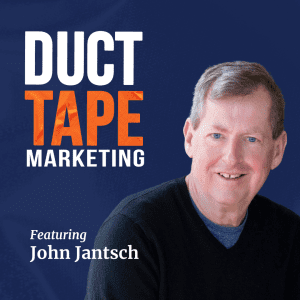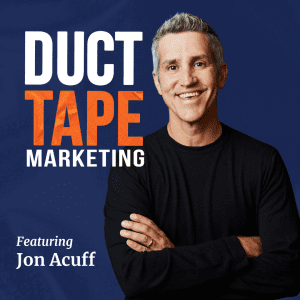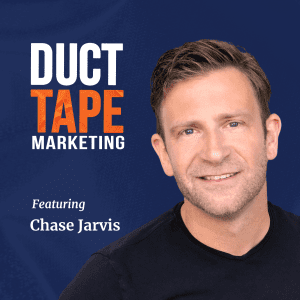Solving the Marketing Leadership Gap for Small Business written by Jarret Redding read more at Duct Tape Marketing
The Duct Tape Marketing Podcast with John Jantsch
 In this episode of the Duct Tape Marketing Podcast, I tackle a critical topic that small businesses face today: the marketing leadership gap. Many small businesses struggle with disconnected marketing efforts, scattered strategies, and stagnant growth, not due to a lack of tactics but because they lack marketing leadership to tie it all together.
In this episode of the Duct Tape Marketing Podcast, I tackle a critical topic that small businesses face today: the marketing leadership gap. Many small businesses struggle with disconnected marketing efforts, scattered strategies, and stagnant growth, not due to a lack of tactics but because they lack marketing leadership to tie it all together.
As we look ahead to the future of marketing in 2025, I dive into why traditional solutions—like hiring agencies or fractional CMOs—often fall short and what businesses must do to implement a long-term marketing strategy that drives sustainable business growth. This episode uncovers how a marketing system combined with leadership can transform small businesses into scalable, successful enterprises.
Key Takeaways:
- Most small businesses fail at marketing not because of a lack of tools or tactics but because of a marketing leadership gap.
- Strong marketing leadership ensures all efforts align with business goals and drive measurable growth.
- Fix foundational issues first: improve messaging, optimize your website, and focus on building trust through content marketing.
- Implement a repeatable marketing system that delivers consistent, long-term results.
- Treat marketing as an asset, not a cost, to increase business value and make your company more attractive for future opportunities.
- Marketing leadership as a service (e.g., fractional CMOs) offers small businesses and agencies an affordable way to gain strategic guidance.
- AI can improve marketing execution but cannot replace the leadership and strategy required for success.
- Agencies should shift their approach to think like architects of marketing systems, not just contractors executing tasks.
- Businesses must focus on long-term marketing strategies instead of quick, disconnected efforts.
- Closing the marketing leadership gap will help small businesses achieve sustainable business growth and success in 2025 and beyond.
Chapters:
- [01:50] The Leadership Gap in Marketing
- [02:57] Why Marketing Leadership Matters
- [03:39] Steps to Fix Marketing Leadership Gap
- [08:48] Marketing Leadership as a Service
This episode of the Duct Tape Marketing Podcast is brought to you by
![]() Nobody does data better than Oracle. Train your AI models at twice the speed and less than half of the cost of other clouds. If you want to do more and spend less, take a free test drive at Oracle.
Nobody does data better than Oracle. Train your AI models at twice the speed and less than half of the cost of other clouds. If you want to do more and spend less, take a free test drive at Oracle.
John Jantsch (00:01.04)
Hello and welcome to another episode of the Duck Tape Marketing Podcast. This is John Jantsch and no guest today. I am doing a solo show. Let’s call this Solving the Marketing Leadership Gap for Small Business. How’s that sound like for a lofty title? Now I could also, we’re ending, depending upon when you’re listening, we’re coming to the end of 2024. I could also title this what I think the future of marketing is, whether you’re an agency or whether you’re a small business owner trying to market your
business. Let me ask you this. Have ever felt your marketing stuck? Have you ever told your agency marketing stuck? Like it’s disconnected, it’s scattered, it’s not driving growth. Look, you’re not alone. I hear that every single day. So that’s what we’re going to talk about. Why I think that happens and what your business can do to fix it. We’re going to explore an issue. I’m not selling anything today. We’re going to explore an issue that I probably will be selling.
solutions more directly for, but I want to get, I want to dive into what I think is at the crux of where we’re going. There’s a lot. I’ve said this earlier in my, I did do a 2025 trends post and I’ve said this a lot. think 2025 is going to make 2020, the change of 2024 pale in comparison. I think we’re going to see so much change that happens with businesses and we’re already seeing it. I’m hearing from agencies.
and business owners saying, hey, something’s going on out there. I’m not getting the leads. I’m not getting the traffic to my website. So I think we’re going to see a big shift in the winners and the losers, if I can say it that way. So look, hopefully you’ve got some big goals for your business, but here’s the missing thing. You’re lacking internal marketing leadership to guide those goals.
Let me focus on that word again, leadership. You might have internal marketing, you might have internal marketing hires, you might have hired an agency that is doing amazing job with your marketing or some aspect of your marketing, but you’re lacking leadership. You’ve got a website, maybe you’re running some ads, posting on social media, but nothing feels very connected and you’re not really seeing the results, right? So the traditional solutions, I already talked about them. Hire an agency.
John Jantsch (02:27.416)
that’s probably going to be very focused on execution, hire full-time marketing leader, maybe a CMO or fractional CMO, maybe pretty expensive. Right. And then the DIY, which hopefully you’ve realized that’s a tough road, right? You don’t have the time. You don’t have the expertise. It’s probably taking you away from the things that really do matter in your business. If you’re going to move your business forward, I’m not saying marketing doesn’t matter. There just might be higher payoff things that you’re more suited.
to do. Most businesses fail at marketing because they lack not because they lack tactics, but they fail because they lack leadership really to tie it all together. And I think that that is been really a theme. Now I’ve, you know, for 30 years, certainly the 20 plus years I’ve been doing this podcast, I’ve been talking about strategy before tactics, and that is a big piece of it. But there’s also a leadership
component. I think you need somebody to take ownership of that strategy and sure that really every marketing effort aligns with your growth goals. It’s not about doing more. It’s about doing the right things in the right order. Number one, developing a marketing strategy, but then having somebody that is there to help you fix the foundational issues really to tie it all together to orchestrate it. A lot of times, you know, when we start working with somebody,
before we can really do much for them in terms of growth or even in brand is we have to get their messaging right. We have to actually, in most cases, redo their brochure website and turn it actually into a sales asset. We have to talk about content that is educational and trust building. And once we get through that foundation, then we need to actually build a repeatable marketing system. One that ensures you’re not just throwing money at the next new thing.
You’re building a machine that works long term. So that’s the component that I think marketing leadership brings. It’s not just somebody that says, this is what we ought to do. This is how we ought to price it. This is how we ought to talk about our products and services. That’s great to have that strategy, that component. But you also need somebody who is really then orchestrating on that. So breaking it down, you need the strategy first, right? Clear path, aligned goals, customer needs.
John Jantsch (04:54.82)
Identify what’s missing, what needs fixing. Then you need to have those foundational issues fixed. Then you need to build a system. And then you actually need to start thinking about marketing as an asset in your business. And by that, mean, you need to start hiring and training a team to take over and keep that system running. that’s, know, if you think about it, if you went out there and hired, you were at a point where you’re like, gosh, we need to take marketing seriously. We need to hire some marketing leadership.
we need to hire a marketing manager. We need to hire a marketing fractional CMO. Well, that person would come in and hopefully you develop a strategy and nine times out of 10 there, they’d say, okay, who are we going to get to do the work? Because I’m, I’m not writing the emails. That’s not my job. and so whether it’s going to be a third party or you’re going to actually bring somebody, in and hire and train those OREX or have your marketing leader hire and train those folks. that’s really what I think the
I think that the agency model today is just what I’m starting to call marketing leadership as a service. So that includes strategy development, foundation fixes, then installing that system and then training and handing off into your business somebody who can actually run that system. That’s the piece that’s really been missing. know, people have either hired somebody one off, didn’t really know what to tell them to do. They got a little result, but it seemed
seem like they weren’t getting anything or they’ve hired an agency. Same thing. Nobody was directing them. Or maybe they’ve hired somebody to come in and build a strategy, but then nobody to really execute that. So, marketing leadership, I believe, is the missing link for most small businesses. And I believe that agencies today, if you are an agency, a consultant, marketing strategist out there listening, this idea of selling marketing leadership
as a service, I hope actually set some bells off and in some cases alarm bells, because this is what the market needs. And I think that you’re going to find not only are people going to want it, they’re going to want to pay a premium or expect to pay a premium for that person who can bring leadership. AI cannot provide strategy. AI cannot provide leadership. Agencies need to start thinking like
John Jantsch (07:17.368)
architects as opposed to contractors don’t do the work. AI is actually going to do a lot of the specialized work. But that leadership component that is executing on a strategy that is building a marketing system, that’s what’s missing. And I’ve been saying marketing is a system, as I said, for 25 years. However, we’re really getting to the point where that’s a very tangible idea. For a lot of folks,
It’s still even though they agreed with me marketing is a system It felt like a vague idea because really what you were doing was plugging people in to do things And it felt very much like traditional marketing but I believe that we are on the crux of or the what’s a better way to say that the precipice. that’s a good word precipice of This idea that we can in fact finally install a marketing system
in a business because of AI and because we are taking this idea as marketing leadership, as a service, as the missing ingredient. So next time you feel like your marketing isn’t working, ask yourself, do I have any leadership? Do I have a system in place to make it work? If not, that’s the first thing you need to fix. But if this conversation resonated with you, stay tuned. We are going to in 2025.
have a very set step one, step two, step three, step four, that really focuses on positioning what we do as bringing this to small midsize businesses. So stay tuned. If you like this idea, if you’re an agency consultant, if you’re a business owner and you like this idea, just reach out to John at ducttapemarketing.com and tell me you like the idea, you want to hear more. And I will tell you how we can actually build marketing as an asset in your business, not
as a cost, not as an expense in your business. It actually can be something that will make your business more valuable, not just because you’ll grow revenue and get more customers, because you’ll be able to show somebody. Let’s say you want to exit your business, you’ll be able to show somebody here’s how our marketing system works. And that can be one of the most valuable things you can do in your business. So take care. If you’re listening to this post 2025, have a happy new year.
John Jantsch (09:41.372)
Happy end of the year and let’s make 2025 rock. Hopefully we’ll see you one of these days out there on the road.
Sign up to receive email updates
Enter your name and email address below and I’ll send you periodic updates about the podcast.

 In this episode of the
In this episode of the 




 Nobody does data better than Oracle. Train your AI models at twice the speed and less than half of the cost of other clouds. If you want to do more and spend less, take a free test drive at
Nobody does data better than Oracle. Train your AI models at twice the speed and less than half of the cost of other clouds. If you want to do more and spend less, take a free test drive at 

